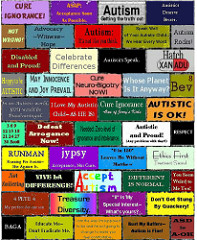Students will fail to succeed, or outright fail a subject, for a variety of reasons. Sometimes they have learning disabilities, sometimes they have health issues, sometimes their underachievement results from motivational issues. Oft times there are sticky combinations of these causes. In any regard, there’s a long and sadly-familiar road trod by the triad of parents, student and school staff in the effort to rectify the situation.
Unless the underlying causes are obvious (such as health issues), the common cause assigned to the student’s underachievement is usually motivational problems. This is especially true if the student did okay in the earlier grades, but their marks gradually slip lower with succeeding years, or their marks are irregular within the same subject. Which is not to say that there might not also be various learning difficulties that are exacerbating the student’s motivational issues – it’s hard to keep applying yourself when you can’t understand why your results are so erratic. When students can’t understand the cause and effect, they tend to assign difficulties to external forces, and feel they they have little power over the results of their efforts.
Unfortunately, the first impulses of the dyad of adults in these situations, those solutions for tracking the student’s progress and ensuring their successful completion of school work, can often end up making the situation worse. Alas, in the end, everyone ends up more stressed than before. The solutions create more problems instead of rectifying them …
Although assignment books or pages are meant to enhance communication between school and home about what the student needs to do, they often end up creating an even tenser situation. (Here we are talking about those that are ongoing missives between the adults, not simply a resource for the student.) These are theoretically carried to and fro by the student, keeping everyone apprised of what has been assigned and has been completed. Unfortunately, the focus of this exercise frequently turns to what the adults need to “make” the student do, and upon what the student has not done. (Note: it’s nearly impossible to “make” someone do something; you cannot “make” a child fall asleep or eat or learn.) The frustrated adults become angry at the student, repeatedly reminding the child of how they have failed yet again. Blame-assigning sets in, and each half of the adult dyad accuses the other of “not doing their part” because obviously, were the other set of adults doing their job, the student would be getting the work done and turn in promptly!
Amazingly, all this tension and attention does not improve the student’s performance. Indeed, the student now feels pitted between two large forces, wanting to please everyone but instead having their incompetence repeatedly confirmed. Instead of empowering everyone to help the student, everyone has instead become disempowered, frustrated, and adversarial.
Sometimes the adult dyad will resort to behavioral report or the daily or weekly progress reports for the student. These can suffer many of the same issues as the assignment book, by focusing entirely upon negatives. When poorly structured, the reports end up being little more than tallies of daily sins. It is very disconcerting for anyone to be under the microscope all the time; slight transgressions and ordinary human weaknesses become quantified and magnified. The child become identified with a bad score, even the hollow nothingness of “being a zero”. The student may also end up in the trap of false dichotomies, seeking to be perfect, and failing that, falling to utter failure. Here the student is expected to take responsibility for their behavior, but then simultaneous loses more of the control and personal power of the situation.
Focusing only on a student’s weaknesses creates a heavily biased view of the student. Everyone has weaknesses, but successful students learn how to lead with their strengths and how to accommodate or compensate for their weaknesses. A good plan needs to focus upon how the student is improving. The student needs help to learn how to plan ahead and effectively deal with inconsistencies in achievement that are simply part of the human condition. They also need to learn how their successes are derived from what they have done, rather than from random outside forces, and how they are not only responsible for their behavior (in the sense of receiving its consequences) but also capable of effective positive changes in it as well.
When many people are faced with noncompliant underlings (students, children or anyone lesser in the hierarchy), their first impulse is to punish them: “When people are bad, they deserve to be punished. When people are good, they deserve to be rewarded.” Rewards in such cases are simply the flip side of punishments. The problems with punishments are complex and not immediately apparent, because the system of punishment and reward (including the heavily-marketed “logical consequences”) is so heavily entrenched in our culture.
The problem with punishments is that they change the focus from the activity itself to those punishments and rewards. They also change the focus from a person’s internal, intrinsic pleasure at doing something, to something extrinsic: the avoidance of pain or the attainment of pleasure. Any activity (even one that is naturally interesting to a person) can lose its natural appeal under such conditions, and people do not work as effectively or as imaginatively. Instead of improving work ability, such external systems actually end up reducing it.
Furthermore, placing punishments and rewards into the situation takes the responsibility from the person doing the work, and places it in the hands of the people handing out the punishments and rewards. It’s no surprise that students end up focused on what they will get for doing something, rather than simply doing it because it needs to be done. Success thus requires an outside system to ensure that the jobs are done. Sometimes the rewards are so far in the future (a month or a semester away) that the cause and effect linkage cannot be made at the simple behavioral level – there’s no relevance to what is happening today, and how the student feels at the moment. Reward inflation also occurs, where ongoing jobs or more complex jobs need bigger and bigger rewards to ensure their completion. Punishment inflation can also occur, because the student may decide that the punishment is not nearly as bad as the fear of failure or other dismotivating state. Ultimatums like being grounded for a month (the parental version of house-arrest) or sending children away also do not work. Either the child knows that the parent won’t follow through, or if they do send the child off to someplace dreadful, the child learns that their scholastic achievements are more important to the parent than their love for the child as a person.
Assignment books, progress reports, or punishments and rewards rarely have good long-term benefits because they are poor teaching tools. They work on the assumption that fear or bribery are good teachers. Not only do they teach the wrong things (fearing and hating authority, or needing to be bribed to do things), they also do not teach the right things.
They don’t teach the person how to persevere when frustrated, or how to solve their own inner difficulties, or how to monitor their own efforts, and how to adapt to new situations. As a result, they don’t help a student become a more independent learner and worker, or how to think critically and problem-solve. In short, they leave students very poorly equipped to be independent adults. (Guess what happens when the student then goes to university …)
We don’t want to assign blame to various people, or to punish our children and students for having problems. Instead, we want to help them learn to problem-solve, and acquire the skills they need so they can figure out how to solve future problems.
This means stepping outside of these established defensive and offensive modes of interaction. It means listening to the student’s frustrations without denying the validity of the feelings (even though the premises upon which they are based may be faulty). It means demonstrating how to break down overwhelming jobs into smaller tasks, and how to create organisational structures that are self-enabling. It means initiating work by starting from a place of competency and asking the student what they do know, rather than telling them what they ought to know. It’s not something that is accomplished quickly, especially when the poor mental habits have taken a long time to become established. It takes a while for the student to re-frame their self-perception, and to install more effective work habits.
Parents and school staff also assign blame on each other, and get defensive when one side asserts that the reason for the student’s difficulties lies in the other’s incompetence. This ends up putting the adult dyad into offensive-defensive modes as well, thus blocking positive change.
We don’t need parents who are better warriors at IEP meetings, when in fact they really want to be helping the teachers understand how neat their children are, and sharing their insights about the child’s strengths and interests.
We don’t need school staff who are better at defending the Local Education Authority’s policies, when in fact what they really want to be doing is sharing their enthusiasm for various subjects with the students, but in fact end up cornered by employers that create systems that interfere with imaginative teaching.
We do need team members who can collaborate with each other and with the student, and who can teach the knowledge and tools they will need to be better masters of their own destinies. That is what education should ultimately be about, rather than about creating more compliant student masses.









